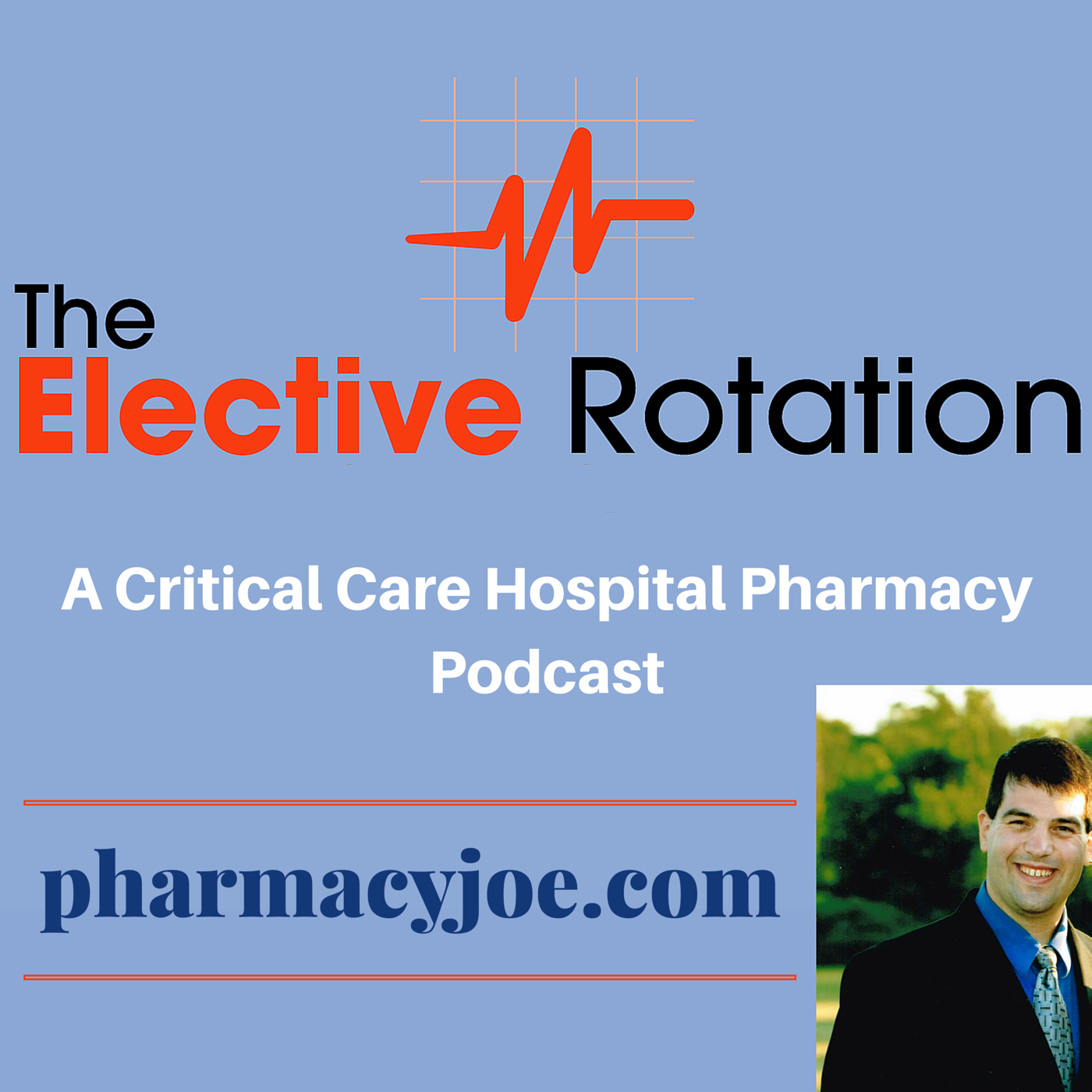In this episode, I’ll discuss the recent updates to the IDSA and ACG C diff guidelines. Subscribe on iTunes, Android, or Stitcher The American College of Gastroenterology published an update to their C Diff guidelines in May of 2021, and The Infectious Disease Society of American published a focused update to their guidelines in June […]
A free twice-weekly podcast where you can listen to critical care and hospital pharmacy information
Subscribe to the #1 ranked critical care and hospital pharmacy podcast, The Elective Rotation here:
Episode 626: What is the minimum effective dose of nebulized ketamine for analgesia?
In this episode, I’ll discuss a recent trial of nebulized ketamine for analgesia in the ED. Subscribe on iTunes, Android, or Stitcher A case series of 5 patients that received nebulized ketamine for analgesia in the emergency department has previously been published. Each patient experienced a decrease in pain from the baseline up to 120 […]
Episode 624: The importance of external validation of clinical prediction models
In this episode, I’ll discuss the importance of external validation of clinical prediction models. Subscribe on iTunes, Android, or Stitcher When a prediction model is developed, it is only known to be valid in the data set that it was developed from. In order to determine a prediction model’s reproducibility and generalizability to new and […]
Episode 623: The connection between respiratory drive and sedation depth might not be what we thought it was…
In this episode, I’ll discuss the connection (or lack thereof) between respiratory drive and sedation depth. Subscribe on iTunes, Android, or Stitcher When mechanically ventilated patients have spontaneous respiratory effort, it is often assumed that providing a deeper level of sedation will depress the respiratory effort and allow compliance with the ventilator. This is a […]
Episode 622: Early dexmedetomidine use and body temperature elevation
In this episode, I’ll discuss early dexmedetomidine use and body temperature elevation. Subscribe on iTunes, Android, or Stitcher Dexmedetomidine has previously been identified as a cause of drug fever in the ICU in case reports, and in my practice, this has seemingly come up often. Investigators recently published a post-hoc analysis of body temperature elevations […]
Episode 621: Should subcutaneous VTE prophylaxis be given during therapeutic hypothermia?
In this episode, I’ll discuss whether subcutaneous VTE prophylaxis should be given during therapeutic hypothermia. Subscribe on iTunes, Android, or Stitcher Shout out to Hospital Pharmacy Academy member, “Pharmacy Yor” for inspiring this episode. During therapeutic hypothermia, subcutaneous drug absorption may be reduced due to low perfusion to the skin. This may be especially true […]
Episode 620: Is 3 days of beta-lactam use enough to treat CAP in non-ICU hospitalized patients?
In this episode, I’ll discuss whether 3 days of beta-lactam use is enough to treat CAP in non-ICU hospitalized patients. Subscribe on iTunes, Android, or Stitcher Presumably, if a shorter duration of antibiotic therapy can be used for patients admitted to hospital with community-acquired pneumonia, then the adverse consequences associated with antibiotic use (bacterial resistance, […]
Episode 619: Management of Antiretrovirals in Critically Ill Patients
In this episode, I’ll discuss the management of antiretrovirals in critically ill patients. Subscribe on iTunes, Android, or Stitcher Management decisions regarding antiretroviral therapies in critically ill patients are complex. Drug interactions, lack of variety of dosage forms and decreased absorption threaten to expose patients to unintended monotherapy. This can promote the emergence of resistance, […]
Episode 618: Does resistance against 1 antipseudomonal beta lactam mean the others can’t be used?
In this episode, I’ll discuss whether resistance against 1 antipseudomonal beta lactam means the others can’t be used. Subscribe on iTunes, Android, or Stitcher The anti-pseudomonal beta-lactams commonly used are ceftazidime, cefepime, meropenem, and piperacillin-tazobactam. Since the resistance mechanisms are similar between these antibiotics, investigators recently examined whether resistance to 1 or more of these […]
Episode 617: When is Prophylactic Anticoagulation, Not Prophylactic Anticoagulation?
In this episode, I’ll discuss when prophylactic anticoagulation, is not prophylactic anticoagulation. Subscribe on iTunes, Android, or Stitcher When clinicians refer to prophylactic levels of anticoagulation in hospitalized patients, this usually refers to doses of anticoagulants that are meant to prevent venous thromboembolism such as deep venous thrombosis (DVT) and pulmonary embolism (PE). Both enoxaparin […]
Episode 616: Is it ever appropriate for a patient to be on oral and IV vancomycin?
In this episode, I’ll discuss whether it is ever appropriate for a patient to be on oral and IV vancomycin. Subscribe on iTunes, Android, or Stitcher While IV vancomycin is indicated to treat a variety of infectious diseases, oral vancomycin is primarily used to treat C diff infection (CDI). Unlike IV metronidazole, which achieves therapeutic […]
Episode 615: Does aspirin work for VTE prophylaxis in orthopedic surgery?
In this episode, I’ll discuss aspirin for VTE prophylaxis in orthopedic surgery. Subscribe on iTunes, Android, or Stitcher When balancing bleeding and clotting risks, I find anecdotally that surgeons often place more emphasis on avoiding bleeding. Years ago, when the CHEST Guidelines expanded the recommended medications for VTE prophylaxis in orthopedic surgery to include aspirin, […]
- « Previous Page
- 1
- …
- 37
- 38
- 39
- 40
- 41
- …
- 90
- Next Page »
